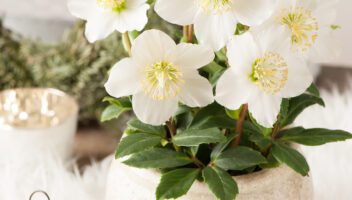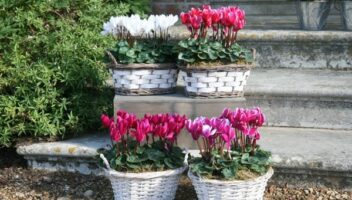Cyclamen are pretty garden friends, bringing joyful dots of jewel-like colour to the garden throughout winter.
Easy to grow, there are varieties to suit a range of situations, from baskets and containers to beds and banks for a more naturalised woodland look.
Top Varieties
Cyclamen persicum (‘Persian cyclamen’)
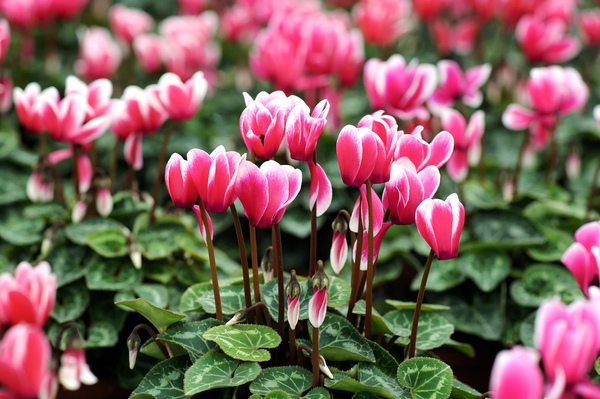 Cyclamen persicum, which flowers from winter into spring, is the most popular variety of cyclamen. Perhaps most commonly known for the larger-flowering indoor variety, often referred to as the ‘florists flower’, there is also a small version, commonly sold as mini Cyclamen, that can be grown outdoors. Growing to around 20cm in height, the delightfully fragrant white or pink flowers sit boldly upright above its heart-shaped leaves. Despite its popularity, C. persicum is not frost tolerant so beware of planting in frost susceptible spots.
Cyclamen persicum, which flowers from winter into spring, is the most popular variety of cyclamen. Perhaps most commonly known for the larger-flowering indoor variety, often referred to as the ‘florists flower’, there is also a small version, commonly sold as mini Cyclamen, that can be grown outdoors. Growing to around 20cm in height, the delightfully fragrant white or pink flowers sit boldly upright above its heart-shaped leaves. Despite its popularity, C. persicum is not frost tolerant so beware of planting in frost susceptible spots.
Flowering time: Winter into early spring
Sun Requirements: Full sun to partial shade
Soil: Moist, well-drained soil
Hardiness: Not hardy
Size: Grows to 20cm height x 20cm width
Cyclamen coum (‘Eastern cyclamen’)
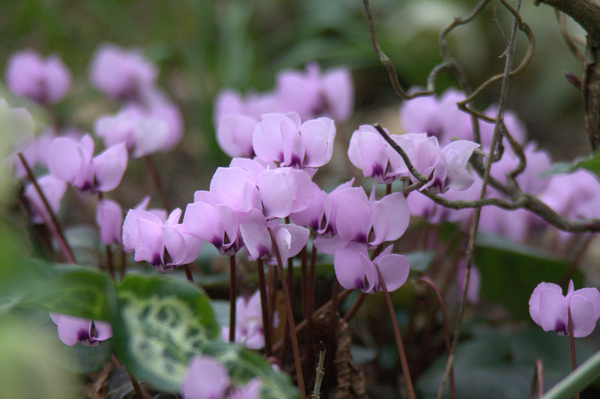 Cyclamen coum is a hardy form with white to pink and crimson flowers from winter into early spring. A dwarf form, growing to just 10cm tall, it has the RHS Award of Garden Merit.
Cyclamen coum is a hardy form with white to pink and crimson flowers from winter into early spring. A dwarf form, growing to just 10cm tall, it has the RHS Award of Garden Merit.
Flowering time: Winter into early spring
Sun Requirements: Partial shade
Soil: Moist, well-drained soil
Hardiness: Hardy to -15°C
Size: Grows to 10cm height x 15cm width
Cyclamen hederifolium (‘ivy-leaved cyclamen’)
 Cyclamen hederifolium is another hardy variety with white to pink flowers with purple throats. It comes into flower in early autumn. The patterned leaves, which resemble ivy (Hedera – where the name ‘hederifolium’ comes from’) follow. Another smaller form, it grows to a little over 10cm in height.
Cyclamen hederifolium is another hardy variety with white to pink flowers with purple throats. It comes into flower in early autumn. The patterned leaves, which resemble ivy (Hedera – where the name ‘hederifolium’ comes from’) follow. Another smaller form, it grows to a little over 10cm in height.
Flowering time: Late summer through to autumn
Sun: Partial shade
Soil: Moist, well-drained soil
Hardiness: Hardy to -15°C
Size: Grows to 15cm height x 15cm width
Cyclamen Growing Guide
Cyclamen is a plant that people often remark they struggle to keep.
Planting
When planting cyclamen outdoors, they need to be placed in a spot where they are protected from hot sun and severe weather. Ideal locations in the garden are under trees or high-branched shrubs. As they are short in height, they are better towards the edge of borders or are ideal in rock gardens. They are also often frequently grown in baskets.
Soil should be well-drained and a good mix of potting grit dug into the existing soil when planting will help. When planting, allow some corm to remain above the surface of the soil and space four to six inches apart.
Watering
If your cyclamen are in containers, be sure to water from the bottom – watering from the top can cause mildew.
Pruning
Deadhead by folding the stem down, taking it right to the base of the flower stalk and giving a little pull to remove it.
Complementary Planting Ideas
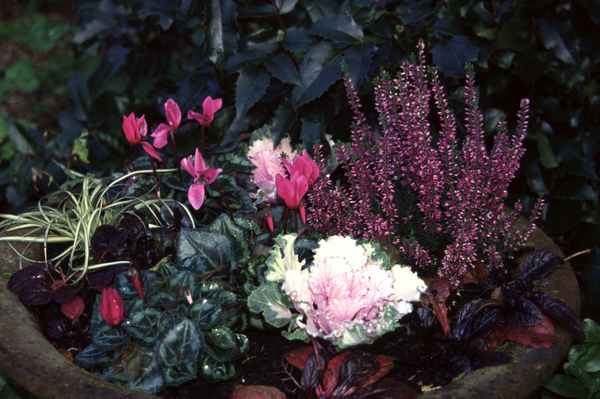
Create a striking winter planted container by mixing bright pink cyclamen with other pink/purple and darker plants, such as erica (heathers) and hedera (ivy).
For a beautiful display in your borders that will take you from winter into spring, plant soft pink Cyclamen coum together with pure white Galanthus nivalis (snowdrops) and inky-black Ophiopogon planiscapus ‘Nigrescens’.
Another brilliant winter planting combination is Cyclamen coum together with Christmas roses, such as Helleborus ‘Wintergold’.
Cyclamen Fact
In centuries past, it was believed that cyclamen plants could be used to treat various medical ailments. This may, unfortunately, be because of their mild toxic properties – in particular, if ingested by cats, dogs or horses. Use in medical preparations is therefore not recommended!


